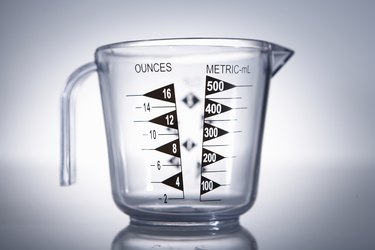Things You'll Need
Plaster of Paris
Water
Measuring cup
Measuring spoons
Salt
Flexible bowl

Mixing up a batch of plaster of Paris is pretty easy. Once it's poured, it can take 20 to 30 minutes for it to set up and get hard. However, there are times when speeding up the plaster's setting or hardening time is important. For instance, if you work on a forensic team and you have to make plaster castings of footprints or tire treads at a crime scene. Naturalists who collect and study animal tracks by casting them out in the wild, may not have time to wait around for plaster to dry. One of the most crucial times when plaster is needed to set up faster than normal is when doing a life mask. Many people get claustrophobic when their face is encased in plaster. The faster they can get a plaster mold off their face, the happier they are.
Step 1
Measure the plaster and water by volume, two parts plaster to one part water. For instance, measure out 2 cups of water and add 4 cups of plaster of Paris.
Video of the Day
Step 2
Pour the water into a flexible container like a plastic bowl. Put on a dust mask and sift the dry plaster of Paris into the water.
Step 3
Add a teaspoon of salt to speed up the setting time.
Step 4
Mix the plaster, salt and water thoroughly with a bare hand. Tap the outside of the container to bring trapped air bubbles to the surface.
Step 5
Pour the liquid plaster.
Tip
Always mix plaster and water in a flexible container. If it dries in the bowl just flex the bowl and the plaster will break free from the sides. A good container in which to mix plaster is a rubber playground ball cut in half. Adding salt to plaster makes it more durable. Besides straight table salt, you can add potassium sulphate or potassium alum to speed up the setting time of plaster. Adding vinegar will slow the setting time of plaster.
Warning
Do not pour leftover liquid plaster down the drain if you don't want it clogged. Instead, let it dry and dump it in the garbage.
Video of the Day